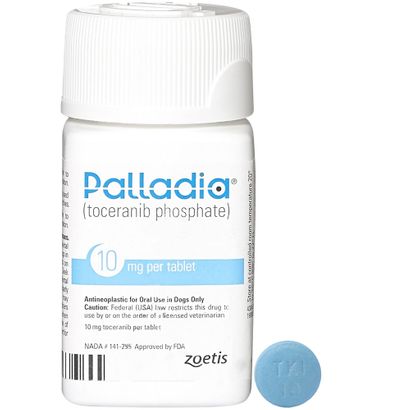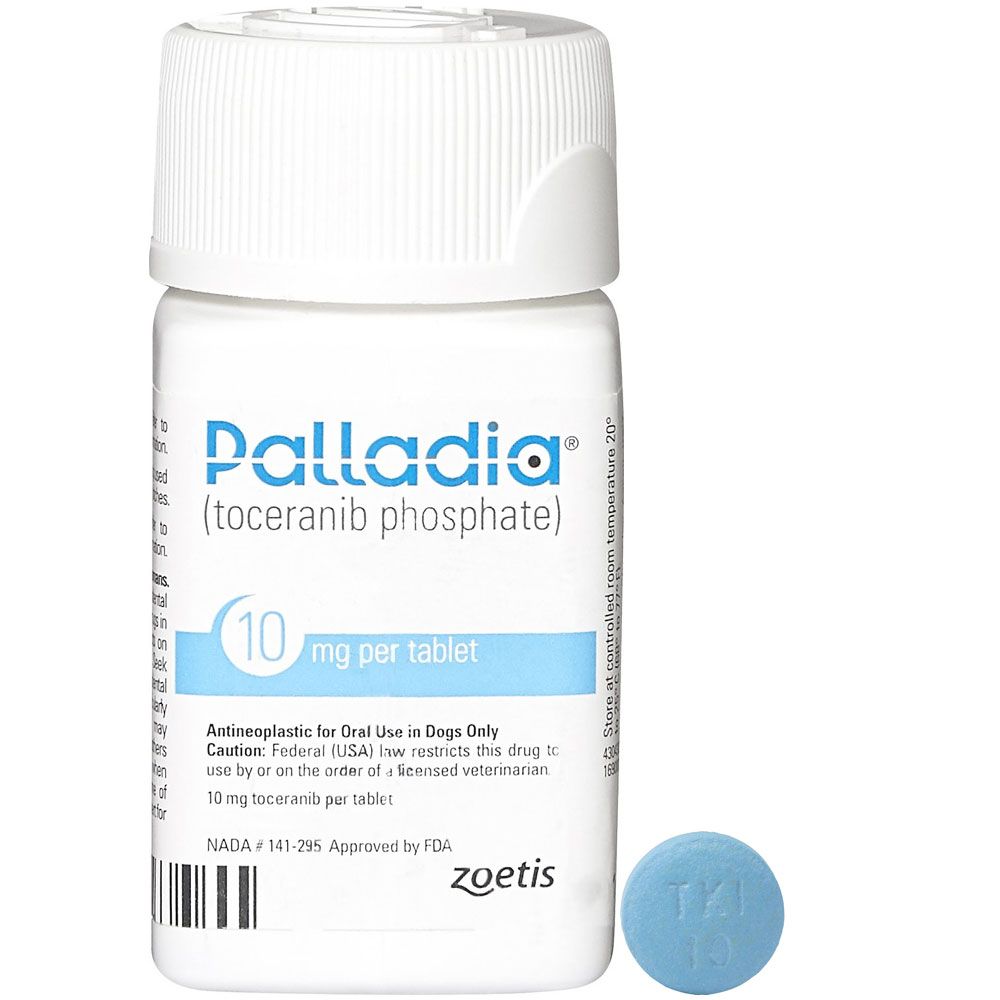Sitewide SALE! GET 15% Off! Use Code EPX15 *

Palladia (toceranib phosphate) Tablets for Dogs
- Notice
- Description
- Ingredients
- Directions
- FAQ
- Reviews
Notices
Limit 1 Palladia products per customer.
Description
Palladia (toceranic phosphate) is an antiproliferative and antiandiogenic agent used to treat Patnaik grade II or III, cutaneous mast cell tumors in dogs. It uses toceranic phosphate to combat the effects of these recurrent tumors and works on both tumors with and without regional lymph node involvement. Palladia can also be used as an alternative to chemotherapy for other various types of tumors, including melanomas, thyroid carcinomas, and more.
Palladia is available in 10 mg, 15 mg, and 50 mg tabs to ensure that adjusting your dog’s dosage based on their weight is a simple manner. Each dosage is available for purchase by the tab or in a container of 30 tabs.
Key Features
- Treats Patnaik grade II or III recurrent, cutaneous mast cell tumors in dogs
- Can be used as alternative to chemotherapy for other types of tumors
- Available in three different dosages in singles doses or packs of 30
Product Uses
- Antiproliferative and antiangiogenic agent
- Prevents tissue inflammation caused by malignant tumors
- Inhibits tyrosine kinase, which kills the tumor cells directly and also interferes with the tumor’s blood supply
Conditions Treated
- For the treatment of dogs with mast cell tumors
- An alternative to chemotherapy for other types of tumors, including:
- Squamous cell carcinoma
- Metastatic osteosarcoma
- Malignant Melanoma
- Anal sac adrenocarcinoma
- Vaccine Associated Fibrosarcoma
- Transitional Cell Carcinoma
- Thyroid Carcinoma
Ingredients
Active Ingredient
Toceranib
Directions
Dosage & Administration
Always provide Client Information Sheet with prescription. Administer an initial dosage of 3.25 mg/kg (1.48 mg/lb) body weight, orally every other day. Dose reductions of 0.5 mg/kg (to a minimum dose of 2.2 mg/kg (1.0 mg/lb) every other day and dose interruptions (cessation of Palladia for up to two weeks) may be utilized, if needed, to manage adverse reactions. Adjust dose based on approximately weekly veterinary assessments for the first 6 weeks and approximately every 6 weeks, thereafter. Palladia may be administered with or without food. Do not split tablets.
Quick Tips
- You should consult a veterinarian to determine the exact dosage that is appropriate for your pet
- The appropriate dosage will depend on the size of your pet
- Dosage will be adjusted over time as needed
- Administer doses orally every other day
- Dose reductions and interruptions can be utilized as advised by your veterinarian
- Your veterinarian should make weekly assessments to determine any necessary adjustments to your pet’s dosage
Dosage Table
| Dog Body Weight | Number Of Tablets | |||||||||||||||||||||||||||||||||||||||||||||||||||||||||||||||||||||||||||||||||||||||||||||||||||||||||||||||||||||||||||||||||||||||||||||||||||||||||||||||||||||||||||||||||||||||||||||||||
|
|
|
Storage Directions
Store at controlled room temperature 20° to 25° C (68° to 77° F). Keep away from children and pets.
Contraindications
Do not use in dogs used for breeding, or for pregnant or lactating bitches.
Warnings
Palladia may cause vascular dysfunction which can lead to edema and thromboembolism, including pulmonary thromboembolism. Discontinue drug until clinical signs and clinical pathology have normalized. To assurevasculature homeostasis, wait at least 3 days after stopping drug before performing surgery.
Human Warnings
NOT FOR USE IN HUMANS. KEEP THIS AND ALL MEDICATIONS OUT OF THE REACH OF CHILDREN.Children should not come in contact with Palladia. Keep children away from feces, urine, or vomit of treated dogs.To avoid exposure to drug, wash hands with soap and water after administering Palladia and wear protective gloves to prevent direct contact with feces, urine, vomit, and broken or moistened Palladia tablets. Place all waste materials in a plastic bag and seal before general disposal. If eyes are accidentally exposed to the drug, rinse eyes with water immediately. In case of accidental ingestion by a person, seek medical advice immediately, show the package insert or label to the physician. Gastrointestinal discomfort such as vomiting or diarrhea may occur if this drug is accidentally ingested.
Pregnant women, women who may become pregnant, or nursing mothers should pay special attention to these handling precautions. (See handling instructions above.) Palladia, like other drugs in its class, prevents the formation of new blood vessels in tumors. In a similar manner, Palladia may affect blood vessel formation in the developing fetus and may harm an unborn baby (cause birth defects). For pregnant women, accidental ingestion of Palladia may have adverse effects on pregnancy.
Potential Side Effects
A US clinical field study of Palladia in 151 client-owned dogs found the following side effects:
- Diarrhea
- Anorexia
- Vomiting
- Lethargy
- Lameness
- Weight Loss
- Bloody Stool
- Dehydration
- Pruritus
- Pigmentation disorder
- Dermatitis
- Musculoskeletal disorder


